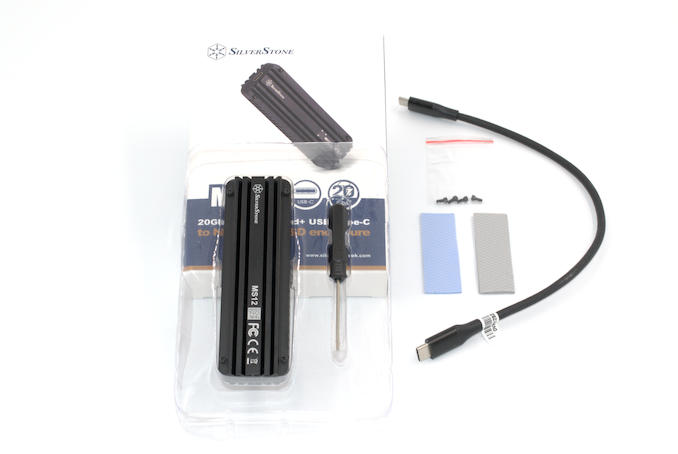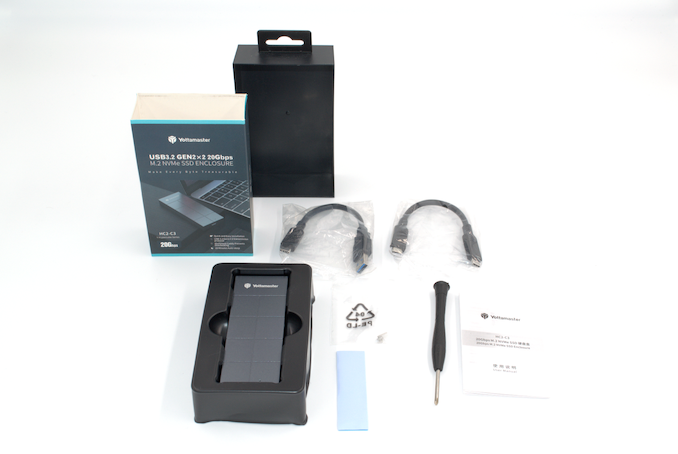Silverstone MS12 and Yottamaster HC2-C3 USB 3.2 Gen 2x2 20Gbps Enclosures Reviewed
by Ganesh T S on August 12, 2021 10:00 AM EST- Posted in
- Storage
- SilverStone
- DAS
- USB 3.2 Gen 2x2
- Portable SSDs
- Yottamaster

Late last year, we took stock of the the state of the USB 3.2 Gen 2x2 ecosystem. It was not a rosy outlook at that time. But since then, many vendors have introduced new products in the 20 Gbps-performance class, and host support has also started to look up. A few new enclosures in this speed class have also appeared in the market.
In parallel, we have seen 3D NAND layer counts go up and QLC become more prevalent. Capacities of SSDs and external bus-powered direct-attached storage (DAS) devices have increased, with 4TB being offered by almost all vendors. Consumer trends in terms of DAS workloads has also undergone some shifts.
To that end, today we're going to take a fresh look at the market for 20Gbps external storage enclosures, thanks to some new enclosures as well as our new DAS test suite. Both SilverStone and Yottamaster have put out new enclosures in recent months with their respective MS12 and HC2-C2 enclosures, and we're anxious to see if the state of Gen 2x2 devices has improved at all in the last several months. So with that said, let's dive in.
Introduction and Product Impressions
External bus-powered storage devices have grown both in storage capacity as well as speeds over the last decade. Thanks to rapid advancements in flash technology (including the advent of 3D NAND and NVMe) as well as faster host interfaces (such as Thunderbolt 3 and USB 3.x), we now have palm-sized flash-based storage devices capable of delivering 3GBps+ speeds. While those speeds can be achieved with Thunderbolt 3/4, mass-market devices tend to rely on USB for cost and compatibility reasons. Within the USB ecosystem, USB 3.2 Gen 2 (10 Gbps) is fast becoming the entry level for thumb drives and portable SSDs. Premium devices sporting the USB 3.2 Gen 2x2 (20 Gbps) interface have been making it to the market over the last 18 months or so, but have been held back by the lack of widespread host support in desktops and other computing platforms.
The SilverStone MS12 and Yottamaster HC2-C3 we are looking at today are both based on the ASMedia ASM2364 bridge chip, and are capable of accommodating M.2 NVMe SSDs up to 80mm in length. Both are aluminum enclosures. While the MS12 comes only with a single Type-C to Type-C cable (USB 3.2 Gen 2x2 is only supported via Type-C), the HC2 comes with both Type-C to Type-C and Type-C to Type-A cables, with the latter capable of operating at up to 10 Gbps. SilverStone provides spare thermal pads along with the ones pre-installed inside the enclosure. The SSD installation involves securing the drive with a screw.

SilverStone MS12 Package Contents
The Yottamaster HC2-C3, on the other hand, supplies thermal pads separately. The package also includes a spare M.2 SSD securing tab, with one pre-installed in the main board inside the unit. The plastic tab solution is a nifty one, as it makes the internal SSD installation a tool-less one. The underside of the case still needs to be secured with a screw, though.

Yottamaster HC2-C3 Package Contents
Both enclosures are being reviewed with the SK hynix Gold P31 1TB NVMe SSD installed, a very solid and low-power drive that's a good fit for these external chassis. The galleries below show the internals of both enclosures.
The thermal solution and SSD mounting mechanisms are brought out in the above pictures. Both these aspects are integral to the user experience. The effectiveness of the thermal solution can be measured objectively (done in a later section), while the mounting mechanism can only be subjectively evaluated. The MS12 utilizes a screw to secure the SSD, while the HC2-C3 adopts a pre-mounted plastic tab. The latter enables a tool-less experience for the mounting segment. User preference may depend on the usage scenario - in cases where the NVMe SSD needs to be frequently swapped out, the HC2-C3's plastic tab mechanism is preferable. The MS12's screw-based solution is a time-tested one and is inherently sturdier. The bridge chip (ASMedia ASM2364) is also visible in the gallery photos.
Meanwhile, as part of taking a fresh look at the state of external USB enclosures, we have moved to a new DAS testbed in order to enable the processing of our tweaked DAS test suite. We'll dive into this more on the next page, but among other changes, moving forward we'll be reviewing all NVMe SSD enclosures with the same SK hynix P31 in order to make apples-to-apples comparisons related to the thermal solution and other aspects.
But getting back to our enclosures, both support S.M.A.R.T passthrough, as shown in the CrystalDiskInfo screenshots below.
| S.M.A.R.T Passthrough - CrystalDiskInfo | |
 |
 |
The table below presents a comparative view of the specifications of the different storage bridges presented in this review.
| Comparative Storage Bridges Configuration | ||
| Aspect | ||
| Downstream Port | 1x PCIe 3.0 x4 (M.2 NVMe) | 1x PCIe 3.0 x4 (M.2 NVMe) |
| Upstream Port | USB 3.2 Gen 2x2 Type-C | USB 3.2 Gen 2x2 Type-C |
| Bridge Chip | ASMedia ASM2364 | ASMedia ASM2364 |
| Power | Bus Powered | Bus Powered |
| Use Case | M.2 2242 / 2260 / 2280 NVMe SSD enclosure DIY 2GBps-class, compact, and sturdy portable SSD with a USB flash drive-like form-factor |
M.2 2230 / 2242 / 2260 / 2280 NVMe SSD enclosure DIY 2GBps-class, compact, and sturdy portable SSD with a USB flash drive-like form-factor |
| Physical Dimensions | 107 mm x 34 mm x 16 mm | 105 mm x 40 mm x 12 mm |
| Weight | 53 grams (without cable / SSD ; with thermal pads) | 60 grams (without cable / SSD ; with thermal pads) |
| Cable | 30 cm USB 3.2 Gen 2x2 Type-C to Type-C | 16 cm USB 3.2 Gen 2x2 Type-C to Type-C 16 cmd USB 3.2 Gen 2 Type-C to Type-A |
| S.M.A.R.T Passthrough | Yes | Yes |
| UASP Support | Yes | Yes |
| TRIM Passthrough | Yes | Yes |
| Hardware Encryption | SSD-dependent | SSD-dependent |
| Evaluated Storage | SK hynix P31 PCIe 3.0 x4 NVMe SSD SK hynix 128L 3D TLC |
SK hynix P31 PCIe 3.0 x4 NVMe SSD SK hynix 128L 3D TLC |
| Price | USD 70 | USD 139 |
| Review Link | SilverStone MS12 Review | Yottamaster HC2-C3 Review |
Prior to looking at the benchmark numbers, power consumption, and thermal solution effectiveness, a description of the testbed setup and evaluation methodology is provided.






















21 Comments
View All Comments
meacupla - Thursday, August 12, 2021 - link
Oh, look at that! a newish NVMe to USB bridge chip from ASMediaEven though I know this chip blows the competition out of the water, I would have liked to see how this chip compares to its predecessors, ASM2362, RTL9210 and JMS583.
Was there any stability or drop out issues with these units? I didn't see any mention in the article, so I assume it was smooth sailing, which is nice to see.
Drkrieger01 - Thursday, August 12, 2021 - link
I'd also be curious to know if they experienced any drop outs during testing. I saw this a fair bit with some JMicron controller based units, but I found flashing to another firmware helped tremendously.Nice to see some new hardware available for those still using Sneaker-Mail.
ganeshts - Friday, August 13, 2021 - link
No issues with these two storage bridges attached to the ECU06. I did experience dropouts last year with the Yottamaster C5 [ as documented here : https://www.anandtech.com/show/16133/usb-32-gen-2x... ].name99 - Thursday, August 12, 2021 - link
"USB 2.0 ports are guaranteed to deliver only 4.5W (900mA @ 5V). "No. USB2 ports guarantee 2.5W. It's USB3 ports (blue connector) that guarantee 4.5W.
And lots of USB3 stuff will just fail (possibly randomly) when connected to USB2 because
- 2.5W is enough to get the drive awake and to read, maybe even an occasional write, but not enough for a run of sustained writes.
- I don't think power negotiation is part of baseline USB3 spec. (Or if it is, most of that hardware doesn't seem to implement it properly.)
repoman27 - Sunday, August 15, 2021 - link
Yep. USB 2.0 is up to 2.5 W (500 mA @ 5 V), while USB 3.2 specifies up to 4.5 W (900 mA @ 5 V) for single lane operation and up to 7.5 W (1500 mA @ 5 V) for dual-lane operation.DigitalFreak - Thursday, August 12, 2021 - link
USB 3.2 Gen 2x2, a standard that had little reason to exist.DigitalFreak - Thursday, August 12, 2021 - link
I guess at least it wasn't called USB 3.3 Gen 3.back2future - Monday, August 16, 2021 - link
within time, seen from now, yes, but what to recommend?Waiting for Thunderbolt 4 or building on USB 4.x?
dwillmore - Thursday, August 12, 2021 - link
I read the testbed page--which I usually skip--because I wanted to know where the heck you found a USB3.2 gen 2x2 port. AiC of course.... On the way I learned about the new Type-E connector for internal connection to case USB-C ports. So, that was nice. I even found a USB 3.2 Gen1x2 host adapter--which is a cursed item if ever there was one.watersb - Friday, August 13, 2021 - link
One of my favorite segments to review right now. My laptop purchased in 2021 is by far the most capable device I own. USB4 or whatever they are calling it this week for fast mobile backup storage is a key part of the workflow.Utterly stupefying how clumsy the market messaging has been. The only way to know what I'm are buying is to test it myself. Or get a review from a source that I can trust to go beyond "it looks pretty and we have a relationship with this brand". YouTube reviews have become more sophisticated, but the professionals here help a lot. Thanks!